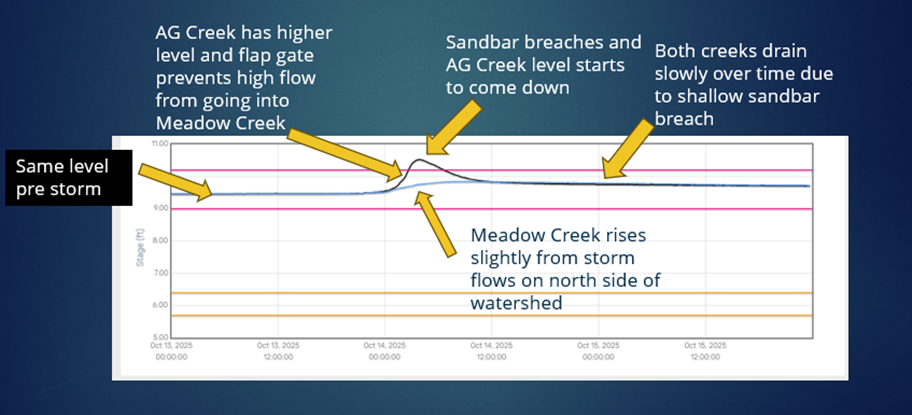


County of San Luis Obispo
Zone 1/1A includes the maintenance and operations of the Arroyo Grande and Los Berros Channels to ensure effective flood protection for the flood control zones located in the City of Arroyo Grande and the community of Oceano.
Updates and InformationClick here to access important storm and flood safety information for the Arroyo Grande Creek Levee and surrounding areas. Click here to subscribe to the Zone 1/1A email notification list.BackgroundThe Arroyo Grande Creek Flood Control Project (Flood Control Zone 1/1A – Arroyo Grande Creek Channel) was constructed in 1961 by the former U.S. Soil Conservation Service. Its primary features include a 3.5-mile levee system and trapezoidal channel confining Arroyo Grande Creek from Los Berros Creek to the Pacific Ocean. The lower reach of Los Berros Creek is also confined upstream of the Highway 1 bridge to the confluence with the Arroyo Grande Creek Channel. Runoff from the Meadow Creek Watershed, which runs through Pismo Lake, is directed into Arroyo Grande Creek through flap gates near the Pismo Dunes State Vehicular Recreation Area. After construction, the San Luis Obispo County Flood Control and Water Conservation District assumed responsibility for maintaining vegetation, sediment, and levee infrastructure. The system was originally designed to provide 50-year flood protection, with freeboard allowing up to a 100-year flood event (10,000 cubic feet per second or cfs) before overtopping. By the 1990s, maintenance was limited due to funding constraints and concerns over impacts to sensitive aquatic and riparian habitat. Although a 2006 special tax assessment increased funding, protections for listed species such as California red-legged frog and steelhead continued to restrict vegetation and sediment removal. Ongoing development has also reduced the project’s effective flood protection. A flood with a 50-year recurrence interval in 1955 is now estimated to occur every 15-20 years due to increased impervious surfaces and altered watershed hydrology. Waterway Management ProgramAfter evaluating alternatives and securing regulatory permits, the District developed the Arroyo Grande Creek Channel Waterway Management Program (WMP) and implemented a project completed in 2020. The project was designed to convey 5,400 cfs (a 10-year event under current conditions) with additional freeboard allowing up to 8,000 cfs. Ongoing activities of the WMP include annual vegetation maintenance, targeted sediment removal, and habitat improvements. See the video below for more information on the 2020 project. Annual vegetation management helps maintain flood capacity and reduces the risk of debris jams during high flows. The District uses several methods to manage vegetation while complying with environmental regulations. Vegetation is removed from the low flow channel and the secondary channels to maintain the targeted flood capacity and freeboard. Weed abatement by grazing is performed in the Los Berros Diversion Channel and in portions of the Arroyo Grande Creek Channel between the Union Pacific Railroad and Highway 1 bridges, where goats clear dense vegetation on channel tops and slopes. Hand crews trim willows, remove non-native invasive species, and collect trash throughout both channels. Sediment accumulation monitoring is performed annually, and results guide sediment removal under the WMP. Sediment monitoring during the initial years after the implementation of the WMP showed no meaningful accumulation in the channel. This changed during the severe 2023 winter storms, which deposited significant sediment and reduced conveyance capacity. In response, the District removed approximately 11,500 cubic yards of sediment to restore the channel’s capacity. Culvert and Flap Gate Maintenance is completed every year in September prior to the storm season. Culverts and flap gates are inspected, cleaned, and maintained to ensure proper water flow. Accumulated sediment is removed from the flap gate outfall during low-flow conditions to avoid disturbing critical habitat for sensitive species such as the tidewater goby. Culverts and flap gates are routinely checked throughout the winter and before every storm. Levee Repair and Maintenance is completed as needed and before winter storms. Routine levee inspections identify required work, such as filling low areas or repairing eroded slopes. The County Public Works Department coordinates the maintenance of the channels. If you need to report a maintenance issue or problem in the channels, please call (805) 781-5252 or submit a request by clicking here. |
Click here to subscribe to the Zone 1/1A email notification list.Additional Resources
|
Zone 1/1A Advisory Committee Meeting CalendarAgendas, Minutes and Updates |
Recent Projects |




Director
3/17/2026 3:00 PM
Sheriff's South Patrol Station, 1681 Front Street Oceano, CA